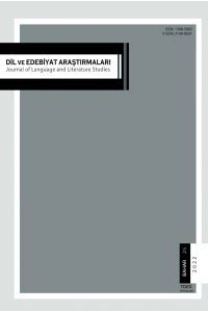Türkiye Türkçesinde İkili Ünlüler
Standart Türkçenin tek ünlüleri (monophthong) /a, e, ı, i, o, ö, u, ü/ ünlüleridir. Bir hece içinde, ünlüyle başlayıp başka bir ünlüyle biten ve birleşik bir ses olarak tanımlayabileceğimiz ikili ünlü (diphthong) ise Türkçede bir sesbirim olarak bulunmaz. Oysa Türkçede bazı fonetik pozisyonlarda ou, ei, öü vb. ikili ünlülerin ortaya çıkması ve dolayısıyla ikili ünlüleşme (diphthongisation) hadisesinin görülmesi söz konusudur. İkili ünlülerin literatürde ikiz ünlü, kayan ünlü, çift ünlü gibi farklı adlandırmalarla karşımıza çıkması, ikili ünlünün en temel kriteri diyebileceğimiz tek bir hecede bulunması hususunun çoğu araştırmacı tarafından göz ardı edilmesi ve Türkçeye alıntılanan bazı sözcüklerde yan yana bulunan iki ünlünün, imla ve telaffuzu birbirine karıştırmak suretiyle ikili ünlü olarak nitelendirilmesi, Türkiye Türkçesindeki ikili ünlüleri ana hatlarıyla konu edinen teorik bir çalışmanın kaleme alınmasını gerektirmiştir. Bu bağlamda öncelikle ikili ünlülere dair literatüre yer verilmiş, akabinde Türkçede /ğ/ sesbirimi üzerinden gerçekleşen ikili ünlüleşme hadisesine değinilmiştir. Ayrıca İngilizceden Türkçeye geçen ve bünyesinde ikili ünlü bulunduran bazı sözcüklerin ne suretle Türkçenin fonetik yapısına uyarlandığı tartışılmıştır.
Anahtar Kelimeler:
Türkiye Türkçesi, sesbilim, ikili ünlü, alıntı sözcükler, /ğ/ sesbirimi
Diphthongs in Turkish
In Turkish, the monophthongs are a, e, ı, i, o, ö, u and ü. However, diphthong is not found as a phoneme in Turkish. In its simplest definition, a diphthong is a compound sound in a syllable which starts with a vowel and ends with another one. Yet, in some phonetic positions in Turkish, it is possible to see the emergence of diphthongs like ou, ei, öü etc. and therefore the occurrence of diphthongisation. Given this, it should be indicated that there are some important problems in the investigation of the diphthongs in the field of Turcology. First, diphthongs have been confusingly conceptualised in the scholarly literature through different forms like ikiz ünlü, kayan ünlü and çift ünlü. Moreover, many researchers have ignored the fact that the most essential criterion of diphthongs is to form a single syllable. Lastly, the two vowels existing side by side in some words borrowed from other languages lead the researchers to characterise them as diphthong since they confuse spelling and pronunciation. These problems in the scholarly literature have certainly necessitated the writing of a theoretical study on diphthongs in Turkish. In this context, this article primarily reviews the literature on diphthongs and then it discusses diphthongisation with special reference to the /ğ/ phoneme in Turkish. Moreover, the article focuses on the matter how the words borrowed from English containing diphthongs have been adapted to the phonetic structure of Turkish.
Keywords:
Turkish, phonology, diphthong, loanwords, phoneme /ğ/,
- ISSN: 1308-5069
- Yayın Aralığı: Yılda 2 Sayı
- Başlangıç: 2010
- Yayıncı: TÜRKİYE DİL VE EDEBİYAT DERNEĞİ
Sayıdaki Diğer Makaleler
Çocuk Edebiyatı Ürünlerinde Göç Kurgusuna Süreç Temelli Bir Bakış
H. Merve ALTIPARMAK YILMAZ, Şeyda ÖZCAN
Üç Yolculuk Şiiri: “Han Duvarları”, “Yol Türküleri”, “Bir Otoyol Liriği”
Margaret Postgate Cole’un Birinci Dünya Savaşı Şiirleri
Türkiye Türkçesinde İkili Ünlüler
Bir Yaz Gecesi Rüyası’nin Türkçe Çevirisinin Ekofeminist Bir İncelemes
Bağımsız Türk Devletleri Millî Marşlarının Değerler Eğitimi Yönünden İncelenmesi
